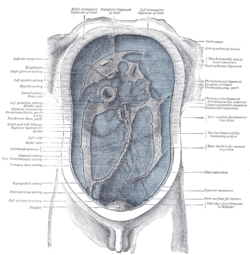| Peritoneum | |
|---|---|
 The peritoneum, colored in blue | |
 | |
| Details | |
| Pronunciation | /ˌpɛrɪtəˈniːəm/ |
| Part of | Abdomen |
| Identifiers | |
| Latin | peritoneum |
| MeSH | D010537 |
| TA98 | A10.1.02.002 A10.1.02.005 A10.1.02.006 |
| TA2 | 3729 |
| TH | H3.04.08.0.00001 |
| FMA | 9584 |
| Anatomical terminology | |
The peritoneum is the serous membrane forming the lining of the abdominal cavity or coelom in amniotes and some invertebrates, such as annelids. It covers most of the intra-abdominal (or coelomic) organs, and is composed of a layer of mesothelium supported by a thin layer of connective tissue. This peritoneal lining of the cavity supports many of the abdominal organs and serves as a conduit for their blood vessels, lymphatic vessels, and nerves.
The abdominal cavity (the space bounded by the vertebrae, abdominal muscles, diaphragm, and pelvic floor) is different from the intraperitoneal space (located within the abdominal cavity but wrapped in peritoneum). The structures within the intraperitoneal space are called "intraperitoneal" (e.g., the stomach and intestines), the structures in the abdominal cavity that are located behind the intraperitoneal space are called "retroperitoneal" (e.g., the kidneys), and those structures below the intraperitoneal space are called "subperitoneal" or "infraperitoneal" (e.g., the bladder).